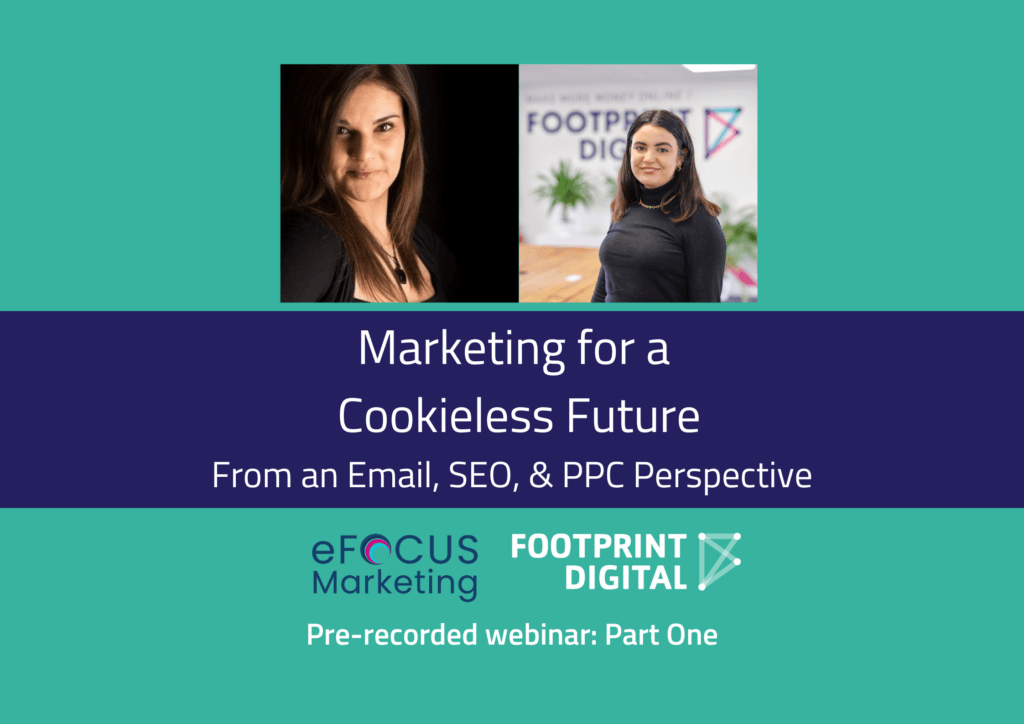

Kaya Heaton: Hi everyone, and welcome to the third instalment in our ‘Marketing for a Cookieless Future Series’. We had a live webinar with Kate in Summer 2023, and then our in person event in partnership with RPC, and now we’re going to be wrapping things up with our watch-on-demand webinar, split into three parts.
My name’s Kaya and I’m a Partnership Development manager at Footprint Digital. I look after our Tech agency and educational Partnerships.
Kate Barrett: And I’m Kate Barrett. I’m the founder and CEO of eFocus marketing and we’re a specialist email marketing agency. I help Brands just like yourselves to use the channel more intelligently and it’s my pleasure to be here with Kaya to see how we can connect the channels that each of our agencies work on to create that combined connection and boost the power of digital marketing campaigns.
The (Third Party) Cookie Will Crumble
Kaya Heaton: ‘Boost the power’ of these campaigns is going to be a bit of a theme today isn’t it? And the main theme is going to be of course changes that are happening in the world of cookies.
We know that the cookie will crumble, but not quite yet, and this reality was underlined when Google announced the delay of their deadline for getting rid of third party cookies for Chrome, which is of course the world’s most popular browser.
We’re seeing changes happening, but I think the prevailing message is that there’s no need to panic because this change is actually creating space for innovation and for new ways of making most of that data. As we all know, advertisers rely on third party cookies to track user behaviour across web server targeted ads.
The worry is that these changes to third party cookies will make it harder to follow a customer’s digital experience and get a full picture of what they’re doing online. But actually we’re already seeing different ways of making most of the data that we will continue to have available to us.
Nothing New to Marketers
Also, these changes are nothing new, Safari and Firefox have blocked third party cookies since 2013 and Google’s delay is leaving enough time for them to really build the infrastructure to make sure that marketers make most of the data in the most privacy-centric way possible for our clients.
Three Different Use Cases
Over the next three videos, we’re going to be covering three different use cases around the ways to cross-pollinate the data. So, we’ll look at different ways to use email segmentation to understand audience demographics and how that email segmentation data and other forms of data can be reused in content online on your website from an SEO perspective, but also off page PPC.
Really what all of this comes down to is that a lot of these forms of marketing and forms of communicating with our audiences are brilliant testing grounds.
- What content is performing well in your emails and could you repurpose that for your paid advertising?
- What content forms do really well in your paid ads in our videos performing extremely?
- How can you think about that in your wide strategy?
Something we say a lot is test and measure always and forever. We don’t want to be making decisions based on gut feeling or opinion. We want to make the best possible decisions with the budget that we have access to.
What do Consumers Want?
It’s all about consumers and what consumers want. They want honesty – 80% of consumers have expressed concern about online privacy. We are in an age where privacy is central. Marketers need to be able to balance privacy and personalization. How can we have these extremely well informed user journeys whilst keeping the user privacy as a central point and getting explicit consent?
The best way to make sure everyone knows and is happy with the data being collected and how you’re using it is ensuring that you offer controls beyond basic permissions.
Making useful and relevant content and using data usefully is extremely important in website content too. Google’s helpful content updates are all around making sure the experiences that we have online are as useful as possible and 74% of consumers consider it important to have a relationship with a brand. So how can we use that in our wide strategy to ensure that we are building that trust in as much of a transparent and privacy centric way as possible?
A Duty to Use Customer Data (Correctly)
Kate Barrett: definitely post GDPR where people give you permission to use their zero and first party data you’ve got to make the most of it and use it in a way that is going to be helpful to your audience. If you’re not using that data, and they’ve given you permission, you’re letting them down.
It’s really important to think about the data you’re collecting and how you can use it to segment, personalise and automate campaigns across your different channels and where you can create that channel connection like Kaya was talking about at the beginning. It’s connecting the messages across those different touch points, but it’s also learning from each of them as to what works and what doesn’t because it’s your same audience across these channels. There is no separation here.
Personalising Email Content
When we think about factors particularly that we can use to personalise email content, because that’s certainly a channel where you can get hyper personalised with what you’re doing, as long as you have the data in place. The first core element that we’re going to be looking at is those past website interactions. What we’re looking at is tracking our email subscribers on our website. So if they’re signed up to receive emails from us we can then see what pages they’re viewing on the website and trigger campaigns off the back of that.
Next up we’ve got past email interactions.
- What have people been opening previously?
- What have they been clicking on?
This data will give you a real idea of their current interests and certainly if you look at this in the recent past you’ll be able to see what they’re telling you about what they want more of.
Then we can look at past practices, or donations if you’re a charity, and past interactions with products or services.
- What have they done with you previously?
- Where have they put their money down?
- Where have they converted with you?
That’s telling you what they’ve needed and when they’ve been motivated enough to make that commitment. Using all of these pieces of data, we’re going to give you a few scenarios that show you how you can use it across multiple elements of your marketing strategy.
The first of those scenarios is website browser behaviour data.
- What pages are they looking at?
- What categories are they looking at?
- What product pages are they spending time on?
- Are they going to your FAQ page?
- Are they adding things to their basket?
- If you’re B2B or your website is for lead gen not direct sales are they starting to fill in a form?
This gives you a wealth of information about what these people are interested in right now.
So in terms of segmenting your audiences for marketing campaigns, we’ve got them kind of identified in our email list in one sense, but in terms of other tracking you can even with that anonymised data what can we do here Kaya?
Kaya Heaton: There is plenty we can do Kate. We’ll still be able to use and target Google Ads powered by Google Chrome’s first party cookies for a while. And there’s of course the Privacy sandbox that I really recommend anyone listening to this webinar goes and has a look into if they haven’t already but what we can do with this Browser Behaviour data is use Google ads insights for email campaigns and SEO on page improvements as well.
As we were saying it’s about the cyclical nature of all of this information. We can use insights data around a specific keyword and its audience to trace that behaviour back. We can walk our way back up the funnel and see what questions they were asking in the first place and there is really no limit to what you can then do with that information.
If you are understanding the questions that were asked to lead a person to convert on your site, you’ve got access to extremely valuable data for creating useful content on the website. How can you answer FAQs before they’ve even become FAQs? This can be turned into blog content or even full campaign ideas that of course then weave in a whole email strategy.
We can segment that data and use email testing for subject lines and calls to actions. We can then link that back to paid ads data.
- What calls to actions are resonating with your email audience?
- Are those same calls to actions working with your paid advertising?
There are so many ways to draw insights from that data that there are rabbit holes you can fall down! A very important part of this whole testing phase is that it needs to be smart. You’ve got to set limits on yourself because you can test yourself into oblivion
There are ways to really think about the data from Google Ads insights.
- What’s performing?
- Are you seeing particular success in certain performance Max campaigns?
There’s a lot of changes happening in Google ads. It’s constantly getting smarter. The AI that’s being used there is of course extremely advanced so a lot of peripheral information can be generated and fed back into that content strategy which opens the door to think about the relationship between your website content and your email content and how that can inform across the campaign.
Browser Behaviour data collected from your website
This leads us to the second element of personalised content within the Browser Behaviour data realm and that is that Browser Behaviour data collected from websites.
Visits can be used to help you create more relevant content based on that conversion and traffic data. So again, what are people asking to lead them to make a purchase with you so we can create more relevant content based on what’s popular and what’s driving conversions, but also understanding those demographics and creating website content accordingly because not everything is relevant for everyone.
A few things to consider here are:
- What does your user journey look like?
- Could educational content help users during that consideration phase?
- At what point in that funnel and that user journey are people?
At the end of the day, we need to know what is driving conversions and how much data can we gain to understand the different touch points that clients had with you along their journey through that consideration phase while they’ve been with your competitors what different bits of content have they interacted with and what has led them to that conversion?
Dropping Out of the Funnel
Are you utilising abandoned basket prompts?
If someone’s coming to your site and you can see the journey that they’ve taken, what point do they stop and what point do they leave the site?
This is something that will explore in more depth in one of the next sessions, but is there something in your user journey that is hindering people?
What problems are your users facing and what is it that you’re selling? We always talk about solving problems rather than selling products. How can you speak to that and to those problems for your consumers rather than just speaking directly about the product or service?
You can use the data to create segments for targeting lookalike audiences and audience expansion. There are all sorts of things from a Google Ads perspective that can be utilised here to think about who those people are with problems that your product solves.
We can understand our audience’s needs through historical data through Google search console. There are all sorts of options for us to go down as marketers, but it’s just about getting that research phase done and then using that to inform your personalised content.
That leads us to the question of what is relevant?
There is a lot of data out there and a lot of rabbit holes that you could fall down that actually result in irrelevant content, spammy content, or communicating too much. Not everything is relevant for everyone so we can use Browser Behaviour data to reduce irrelevant content.
Another benefit of the Browser Behaviour data is that we can use it to widen our reach. Data collected from website visits can be used for increasing email subscribers. We want to drive more traffic to the site to increase the number of subscribers to your newsletter. That’s a great benefit of a brilliantly optimised website that’s coming up for the right search queries in Google will mean that we’ve got a more relevant target audience on site that may be more likely to sign up to our newsletter. Using automated audience expansion widens your reach without the need for first party data as a starting point and from that you can create a much bigger campaign.
This is a point I will dwell on for a moment because with oncoming changes that we mentioned at the beginning of this session, audience expansion is something to keep an eye on as a feature within Google Ads. A consequence of cookies crumbling is that audiences might become smaller, you might have a list of 500 users in the audience that’s going to turn into 100. So what we’re going to be seeing more and more is that audience expansion will be used to find people that look almost the same as current visitors. We can use Google’s data and its infrastructure to help us rebuild those lists and we foresee that there’s going to be a lot of movement on this in the near future.
That leads us to optimised targeting. We’ve got customer match lists, not to be confused with audience expansion, so that’s Google finding people that are likely to convert based on your first party data and of course developments in AI. We’re talking about custom segments and signals and we’re constantly seeing growth in this area and growth in ways that we as marketers can be utilising them. All of this is coming back to that question of how well we know our audience. What do they want? What do they need?
Kate Barrett: The better that we know them the better we can serve up those wants and needs. We’re moving really from that one size fits all and delivering the same content to everyone, through to segmentation where we’re creating groups of similar people within our audience.
That’s great, but we can go to the next level where we have personalisation down to a one-to-one level, which through email is a great way to do it.
I know with a lot of channels segmentation is the best way to get that personalisation in, but we’re very lucky in email that we can go that one step further and literally have individualised product recommendations and content that fits to that individual person that is dynamically served up within the emails.
Presentation and personalisation leads to being able to deliver to our audience relevant contests, content or offers really making them feel like we remember them. The more we can connect this data together and remember them whether it’s offline, online or connecting those online channels together it’s going to help them feel listened to and understood.
The Data Pyramid
Again just really pushing that point that if they’ve given you permission you’re doing them a disservice if you don’t use it, and of course, we’ve got two sides to this data. We’ve got everything that Kaya has been talking about in terms of your content and understanding what is resonating with different types of people within your audience and learning from that behaviour, but the other side that we can use to connect all of this together is around what we call the data pyramid. This is about really understanding your audience and understanding those different pieces of data. So let me talk to you through how that looks.
At the very bottom of the pyramid we have got your ‘known data’.
This is information that your subscribers in this case have given you when they have come through and signed up for your email marketing. We know what their name is. We might know key interests that they have depending on what you ask them.
This is either going to be demographic information (about them as a person) or it’s going to be firmographic (about their business depending on what your business is offering them). You can collect it on sign up forms, through preference centres, or in surveys that people are directly giving you. However, a little warning on this one! Today that’s brilliant data, tomorrow it’s still good, but it can quickly get outdated. Interests can change, what you need in your life changes, what you think you need changes. You may not even know you need it. So if you’re saying you have an interest in a specific area, maybe you just don’t know enough about the other areas that your business is offering. the other categories to say ‘yes, I’m interested’.
The next two sections as we go up our pyramid are cultural and contextual data.
These are external pieces of information that you can bring to layer on to your strategy and the content you’re creating. You’re using this to talk to people with a contextual tone of voice, the types of wording that you use, the types of offers that you promote, the imagery that you pull in whether it’s ads that you’re running or whether it’s your emails, this external information comes into play.
Cultural data is collected through knowledge of the recipient’s locale, whether it’s where they live and different cultural differences between where they live, religion, politics, whatever it is that’s relevant for the content and campaigns you’re creating. That could even come down to different payment methods in different countries, different languages etc.
Contextual data is somewhere in between almost. It;s gathered through tracking where they are, what device they are opening your email or website on etc. You need a third party piece of software in order to give you this information. So something like Movable Ink or Kick Dynamic on real time tracking.
What this allows you to do is at the moment of opening your emails, you can change the content depending on what device someone’s opening on, where they are in the country at that moment in time, what the time of day it is, all of these fantastic pieces of third party data that we’re bringing in based on tracking for opening emails at different times and different places. This is quite an advanced piece of data, you’ll need that extra system to bring in that type of insight, but if you’re ready for that and you want to go to the next level, it’s a great place to go.
As we go up the pyramid, the next section is behavioural data.
This is found using on-site tracking, cookies, email analytics etc and Kaya’s suggested lots of different ways you can use that anonymised data for retargeting and creating segments in Paid Ads. For email marketing it would be based on who’s a subscriber. This is what they’ve then done on your website, but it is also those email analytics that I mentioned earlier. What topics are they opening and clicking on and can you use that for segmentation?
People may not have gone through to purchase yet, but they’re showing those signs of being a warm lead and of being ready to potentially take that next step to the top of your pyramid…
This is your conversion data at the very top.
If you’re b2c, this is going to be your purchase data. What have they bought from you before, how often have they bought from you, how much money have they spent with you, what are those individual products or services that they’ve bought from you? All of that information. I’m sure you’ve got a wealth of it in your commerce platforms!
With all of this data the final stage is to bring it all together and potentially to mix pieces together and put them into segments. Have a look at which of those pieces of data that you’re collecting in each area could be used for personal one-to-one segmentation or personalisation. Now you can do that through yourself as a marketer, perhaps you’ve got a data team to do it, or of course now we’ve got a lot more artificial intelligence available to help us work through that data and understand what’s going to be the best to target our audience with and connect the right content in from all of that other learning that we’ve been doing.
Bringing all of this data together.
This is information that you’re going to be able to firmly get and of course you then got that softer qualitative data more like NPS scores or customer reviews which you can get from social media or online reviews. If you go on to those platforms and have a look at the tone and the sentiment that’s happening on social media and pull that information into how you can improve your campaigns across the board bringing all of this data together is really going to solidify getting you to that much more targeted place with the content that you’re sending out.
Prioritise your known data, your behavioural data and your purchase data because you should have these things quite easily within your business.
What are the characteristics that then you can pull from those pieces of data that show similarities between your audience?
So, a very basic segment would be people who haven’t purchased before and haven’t viewed these pages on the website versus has purchased before and has viewed these pages on the website, there’s a different Journey that you want to take people on.
If somebody hasn’t made a purchase and they’re browsing a specific product or category., they might need a bit more help and support. Maybe they need to be reassured that paying online on your website is secure and safe. Maybe they need some information about postage and delivery because they haven’t experienced that before.
By identifying those similarities and differences we can identify what those different needs are for that audience and link this to what we know works through paid ads or works as the content on our websites to then give us a head start on those email campaigns.
The Combined Journey
Kate: I’m here to talk from an email side. Kaya is here to talk for PPC and SEO and social and all of those other channels. But the reason that we’re here together today is because those customers that we have don’t care if we work for the email side of the business or the social side of the business or wherever it is. They’re interested in that combined journey. We need to understand the connection between those different channels. So if somebody has come on to the website and signed up through a PPC campaign, track that data back and understand what was that term that they came in using, or the specific ads that they came through and as you go into your welcome email series use that information iIf they are browsing certain pages on your website and they’ve given you permission to email them.
Bringing all of this together, it really is about sending the right message to the right person and we can use our data to identify that and particularly browse behaviour is really important to that linking it with email behaviour as well and those other areas of the pyramid but one other place that you can use this to expand that messaging and make sure you’re hitting those messages at the right time is to think about that customer life cycle the funnel that they would go through with your business.
Quickly touching on purchasing experience, here it’s really about making that experience as smooth and enjoyable and helpful as possible. This is really important because that’s going to help to drive that next stage of loyalty, advocacy and retention and inspire them to come back again. We want to keep that experience going every time, and then inevitably there will be subscribers who stop opening or clicking on your emails so is there a different channel that we could perhaps target them through to reinvigorate them and get them to come back to our business?
Understanding how those different pieces of data fit together is really important to target the right message to the right person at the right time and if we think about that behavioural data, that on site data in particular, we’re really bringing that into the consideration stage.







